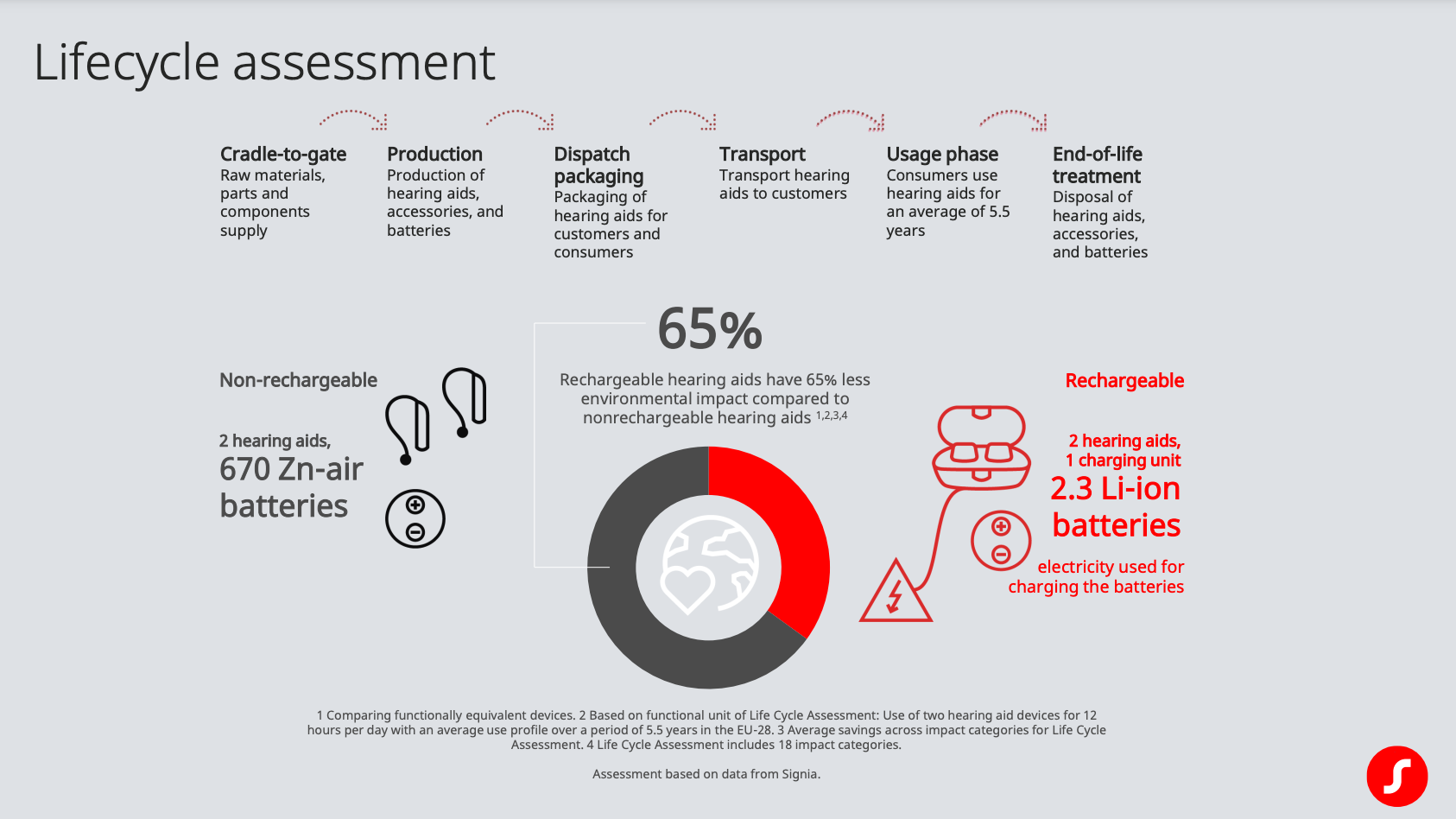A comprehensive life cycle assessment from hearing aid innovator Signia shows that its rechargeable hearing aids have 65% less environmental impact compared to battery-driven hearing aids, saving the average user more than 100 batteries each year.
Piscataway, NJ – December 20, 2021 – Expanding on its ambition to continuously reduce its environmental footprint, hearing aid innovator Signia today published a new study on the environmental benefits of rechargeable hearing aids.
Signia is the first company in the hearing aid industry to have undergone a comprehensive and scientific life cycle assessment (LCA) to compare the lifetime environmental impact of the rechargeable and non-rechargeable hearing aids. The assessment indicates: compared to non-rechargeable Signia AX, the rechargeable Signia Augmented Xperience (AX) reduces the total environmental impact* by 65%, which is an average of reduced impacts of 18 environment categories, including climate change (57%), fossil depletion (52%), human toxicity non-cancer (76%), land use (87%), marine ecotoxicity (78%), etc. A user with two hearing aids can save more than 100 batteries per year.
“At Signia, we are committed to continually improving our environmental footprint, and the biggest lever we have identified is the battery. We want our customers to be aware of how easy it is to positively influence the environmental impact, just by switching to rechargeable hearing aids,” says Frank Naumann, Senior Director of Global Innovation at Signia, who has been in charge of the LCA study.
Sustainability is a core focus for Signia. The LCA results clearly speak to that and are a part of a series of initiatives that Signia have either already in motion or ready to launch in 2022.
The study shows that for non-rechargeable hearing aids, the battery solution (i.e., production, distribution, and disposal of batteries) contributes to more than 80% of the total environmental impact.* On average, for a Signia rechargeable hearing aid, the battery solution (i.e., production, distribution, and disposal of batteries) contributes to only about 5% of the total environmental impact.* Electricity demand for charging contributes on average another 9% of the total environmental impact,* but the difference is still significant.
Signia has an extensive portfolio of rechargeable hearing aids to fit most user needs with up to 61 hours of use on a single charge for the most powerful device.
“We now have solid proof of how much better rechargeable hearing aids can be for the environment, and that is important. But they are also extremely practical and hassle free. Just pop them in the charger at night and you are ready to go all day. Reducing your environmental footprint doesn’t have to mean compromising on quality and comfort. Signia empowers the wearers to make a sustainable choice for the environment and take action so they can live the Signia brand-promise: to enhance human performance,” says Samy Lauriette, Signia’s Global Head of Brand.
Signia has one of the largest offerings on rechargeable products in the industry covering all form factors. Starting from Signia Active X and Insio Charge&Go AX for In-The-Ear solutions to Pure Charge&Go T AX and Styletto X for Receiver-in-Canal devices, and concluding with the Behind-the-Ear solutions, Motion Charge&Go X, Motion Charge&Go P X, and Motion Charge&Go SP X.
The study was conducted by Ramboll and audited by the accredited certification body TÜV NORD. The study follows ISO 14040/44 standards. We keep the assessment report on file.
* Total environmental impact: The total environmental impact throughout the life cycle of the hearing aids, including raw materials, production, transportation, usages, and disposal phases. The total environmental impact includes 18 impact categories, incl. climate change, fine particulate matter formation, fossil depletion, freshwater consumption, freshwater ecotoxicity, freshwater eutrophication, human toxicity, cancer, human toxicity, non-cancer, ionizing radiation, land use, marine ecotoxicity, marine eutrophication, metal depletion, photochemical ozone formation, ecosystems, photochemical ozone formation, human health, stratospheric ozone depletion, terrestrial acidification, and terrestrial ecotoxicity. All statements are based on the underlying functional unit of the assessment; i.e. “Use of two hearing aid devices for 12 hours per day with an average use profile over a period of 5.5 years in the EU-28.”

About Signia
Signia is one of the world’s leading hearing aid brands. We aim to enhance human performance through iconic innovations and consumer-friendly designs that shape the hearing health market. Since its launch in 2016, Signia has regularly brought world-first hearing solutions to the market and is a pioneer in rechargeable hearing technology.
In addition to highly innovative hearing aids, Signia also delivers tools and apps to increase customer interaction and engagement at all levels of hearing aid management. Signia, and its hearing care professionals, enable hearing aid wearers to not just correct hearing loss but to gain an edge – to Be Brilliant.

